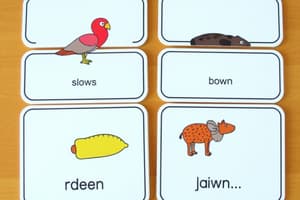Podcast
Questions and Answers
What can be a reason for fluency difficulties for ELLs?
What can be a reason for fluency difficulties for ELLs?
Must have fluency in speaking before writing; decoding, comprehension, and fluency all work together; self-conscious about reading out loud with accents.
What is an important aspect of phonics support for ELLs?
What is an important aspect of phonics support for ELLs?
Knowledge of native language using Roman or non-Roman words.
Which of the following is a method to support phonemic awareness for ELLs?
Which of the following is a method to support phonemic awareness for ELLs?
- Avoid using native language references
- Read silently without external sound patterns
- Experience fun songs and poems to be introduced to sound patterns (correct)
- Focus solely on writing skills
Context clues are always successful for understanding word meaning.
Context clues are always successful for understanding word meaning.
What does the term 'Affix' refer to?
What does the term 'Affix' refer to?
What is the Alphabetic Principle?
What is the Alphabetic Principle?
What is Chunked Text?
What is Chunked Text?
What are Concepts/Conventions of Print?
What are Concepts/Conventions of Print?
What is Connected Text?
What is Connected Text?
What is a Consonant Blend?
What is a Consonant Blend?
What is a Consonant Digraph?
What is a Consonant Digraph?
What is a Cueing System?
What is a Cueing System?
What defines Decodable Text?
What defines Decodable Text?
What is a Derivational Affix?
What is a Derivational Affix?
What are Digraphs?
What are Digraphs?
What is a Diphthong?
What is a Diphthong?
What is Discourse?
What is Discourse?
What are Elkonin Boxes?
What are Elkonin Boxes?
What is Etymology?
What is Etymology?
What are the 5 Components of Reading?
What are the 5 Components of Reading?
What is Flexible Grouping?
What is Flexible Grouping?
What is the Floss Rule?
What is the Floss Rule?
What is a Grapheme?
What is a Grapheme?
What is Graphophonics?
What is Graphophonics?
What is a Homograph?
What is a Homograph?
What is the Independent Reading Level?
What is the Independent Reading Level?
What are Inversions?
What are Inversions?
What is Language Structure?
What is Language Structure?
What is the Linguistic Approach?
What is the Linguistic Approach?
What is a Morpheme?
What is a Morpheme?
What are Oddities in language?
What are Oddities in language?
What is Orthography?
What is Orthography?
What are Phonemes?
What are Phonemes?
What is a Phonogram?
What is a Phonogram?
What is Pragmatics?
What is Pragmatics?
What is Prosody in reading?
What is Prosody in reading?
What is a Root in linguistics?
What is a Root in linguistics?
What is Schema?
What is Schema?
What is Semantics?
What is Semantics?
What are the types of Syllable Types?
What are the types of Syllable Types?
What is Syntax?
What is Syntax?
What are Target Words?
What are Target Words?
What is the Utility of a word?
What is the Utility of a word?
What is a Vowel Digraph/Vowel Pair?
What is a Vowel Digraph/Vowel Pair?
What is Phonological Awareness?
What is Phonological Awareness?
What is Phonics?
What is Phonics?
What is Phoneme Isolation?
What is Phoneme Isolation?
What is Phoneme Identification?
What is Phoneme Identification?
What is Phoneme Categorization?
What is Phoneme Categorization?
What is Phoneme Blending?
What is Phoneme Blending?
What is Phoneme Segmentation?
What is Phoneme Segmentation?
What is Phoneme Deletion?
What is Phoneme Deletion?
What is Phoneme Addition?
What is Phoneme Addition?
What is Phoneme Substitution?
What is Phoneme Substitution?
What are the three cueing systems of Semantics?
What are the three cueing systems of Semantics?
What are the three cueing systems of Syntax?
What are the three cueing systems of Syntax?
What are the three cueing systems of Phonics?
What are the three cueing systems of Phonics?
What are Final Y Generalizations?
What are Final Y Generalizations?
What are Digraph Generalizations?
What are Digraph Generalizations?
What are Silent E Generalizations?
What are Silent E Generalizations?
What are R Controlled Vowels Generalizations?
What are R Controlled Vowels Generalizations?
What is Analytic Phonics?
What is Analytic Phonics?
What is Synthetic Phonics?
What is Synthetic Phonics?
What are Emergent Readers?
What are Emergent Readers?
What are Early/Beginning Readers?
What are Early/Beginning Readers?
What is Fluency in reading?
What is Fluency in reading?
What is the Instructional Level for reading?
What is the Instructional Level for reading?
What is the Frustration Level of reading?
What is the Frustration Level of reading?
What are Oral Reading Fluency Strategies?
What are Oral Reading Fluency Strategies?
What does Spelling Joining Syllables involve?
What does Spelling Joining Syllables involve?
What does Accent and Stress in Spelling help identify?
What does Accent and Stress in Spelling help identify?
What is Related Meaning Spelling?
What is Related Meaning Spelling?
What does Suffix Spellings involve?
What does Suffix Spellings involve?
What are Vocabulary Domains?
What are Vocabulary Domains?
What are Before Reading Strategies?
What are Before Reading Strategies?
What are During Reading Strategies?
What are During Reading Strategies?
What are After Reading Strategies?
What are After Reading Strategies?
What are Comprehension of Informational Texts strategies?
What are Comprehension of Informational Texts strategies?
What are types of Informational Text Structure?
What are types of Informational Text Structure?
What are Elements to Assess in reading?
What are Elements to Assess in reading?
What are the focuses for Emergent Readers & Writers Instruction?
What are the focuses for Emergent Readers & Writers Instruction?
What are characteristics of Emergent Readers & Writers (Pre-K to 1st grade)?
What are characteristics of Emergent Readers & Writers (Pre-K to 1st grade)?
What teaching strategies are important for Early Readers?
What teaching strategies are important for Early Readers?
What are characteristics of Early Readers (1st-2nd grade)?
What are characteristics of Early Readers (1st-2nd grade)?
What are characteristics of Early Writing (1st-2nd grade)?
What are characteristics of Early Writing (1st-2nd grade)?
What are characteristics of Early Fluent/Fluent Readers (2nd-3rd grade)?
What are characteristics of Early Fluent/Fluent Readers (2nd-3rd grade)?
What are characteristics of Early Fluent/Fluent Writing (2nd-3rd grade)?
What are characteristics of Early Fluent/Fluent Writing (2nd-3rd grade)?
What strategies are important for Early Fluent/Fluent Instruction?
What strategies are important for Early Fluent/Fluent Instruction?
What is the use of Phonics in reading instruction?
What is the use of Phonics in reading instruction?
What is Analysis of Word Structure in reading instruction?
What is Analysis of Word Structure in reading instruction?
What is the use of Context Clues?
What is the use of Context Clues?
What is Identification of Sight Words?
What is Identification of Sight Words?
What is Literal Comprehension?
What is Literal Comprehension?
What is Inferential Comprehension?
What is Inferential Comprehension?
What is Engagement of Schema?
What is Engagement of Schema?
What is Self-Monitoring in reading?
What is Self-Monitoring in reading?
What is Open Response Set Up?
What is Open Response Set Up?
What are Instructional Adjustments for ELLs?
What are Instructional Adjustments for ELLs?
What are Comprehension Supports for ELLs?
What are Comprehension Supports for ELLs?
What are Vocabulary Supports for ELLs?
What are Vocabulary Supports for ELLs?
Flashcards are hidden until you start studying
Study Notes
Vocabulary and Phonics Concepts
- Affix: General term for prefixes and suffixes.
- Alphabetic Principle: Concept that letters represent phonemes in written words.
- Consonant Blend: Two or more consecutive consonants that retain their individual sounds (e.g., "bl" in "block").
- Consonant Digraph: Two consecutive consonants representing one phoneme (e.g., "ch," "sh").
- Vowel Digraph/Vowel Pair: Two vowels together that represent one sound (e.g., "ai," "oa").
Reading Comprehension and Strategies
- Decodable Text: Text where 80-90% of words are based on sound-symbol relationships previously taught.
- Phonemic Awareness: Includes skills like phoneme isolation, blending, segmentation, and substitution.
- Comprehension of Informational Texts: Emphasizes increased exposure and explicit teaching of strategies.
- During Reading Strategies: Techniques such as checking predictions, making inferences, and recognizing cause-and-effect relationships.
Print Concepts and Structure
- Concepts/Conventions of Print: Rules governing written language use, such as reading direction and punctuation.
- Language Structure: Organization of words into meaningful segments using grammar and syntax.
- Orthography: A writing system for representing a language.
Phonological and Phonemic Skills
- Phoneme: Smallest unit of sound in a language, combined to create words.
- Morpheme: The smallest unit of meaning in language.
- Phonological Awareness: Includes activities like rhyming and syllable counting to enhance sound recognition.
Fluency and Instructional Strategies
- Fluency: Reading smoothly and accurately with appropriate expression and intonation.
- Instructional Level: Defined as reading with 90-94% accuracy, while frustration level is below 90%.
- Emergent Readers: Focus on concepts about print and basic phonological awareness.
Vocabulary and ELL Support
- Vocabulary Domains: Tiers of vocabulary from familiar words (Tier 1) to domain-specific terminology (Tier 3).
- Comprehension Supports for ELLs: Use of nonverbal aids and explicit teaching strategies to enhance understanding.
- Phonics Support for ELLs: Highlight the different letter combinations across languages while emphasizing meaning in reading.
Writing and Communication
- Discourse: The way sentences are combined to communicate ideas effectively.
- Syntax: The arrangement and structure of words in sentences according to grammatical rules.
- Self-Monitoring: Awareness of comprehension breaks and the application of strategies to maintain understanding.
Evaluation and Assessment
- Elements to Assess: Key focus areas include emergent literacy, fluency, comprehension, and interest in reading.
- Open Response Set Up: Framework for identifying strengths and weaknesses in reading performance, supported by evidence.
Strategy Implementation Focus
- Flexible Grouping: Organizing students based on instructional needs and abilities for targeted learning.
- Before Reading Strategies: Strategies such as activating prior knowledge and utilizing text features to enhance engagement.
Generalization and Rules
- Final Y Generalizations: Understanding that "y" acts as a vowel in final positions (e.g., "merry").
- Floss Rule: One-syllable words ending in f, l, or s typically double the consonant after a vowel.
These notes summarize critical concepts and strategies essential for understanding reading, phonics, and instructional approaches within literacy education.
Studying That Suits You
Use AI to generate personalized quizzes and flashcards to suit your learning preferences.




